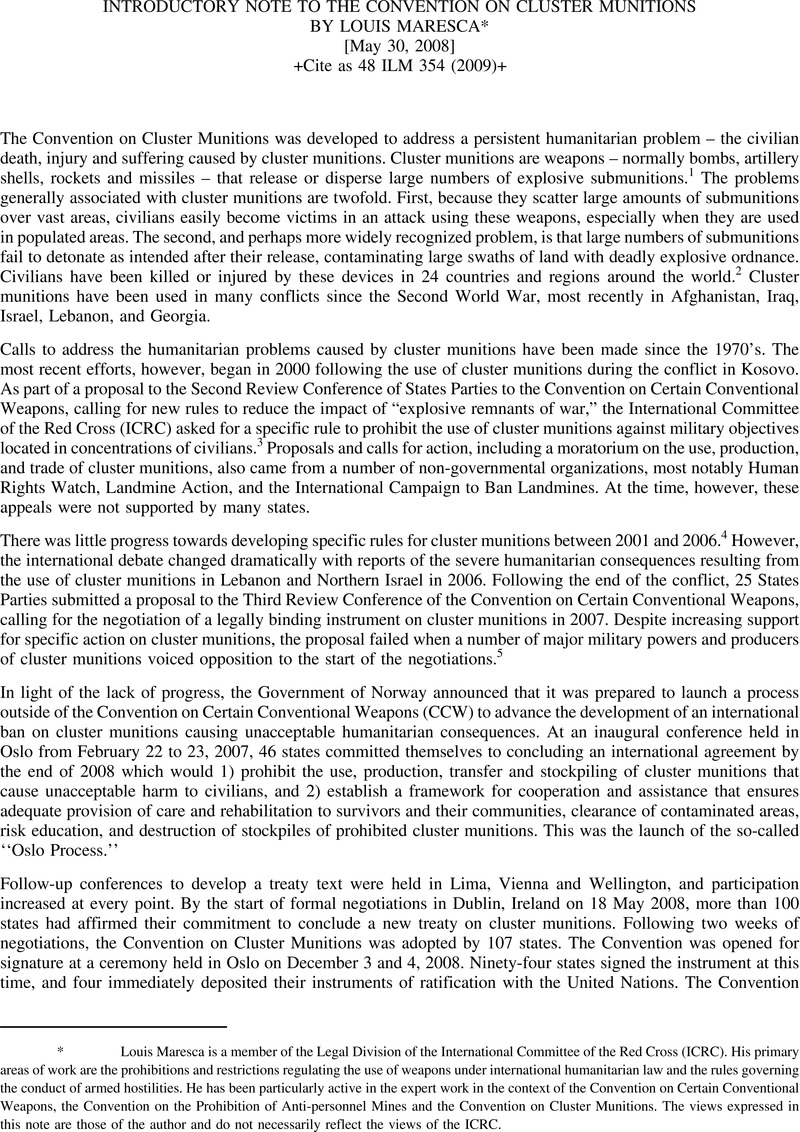No CrossRef data available.
Article contents
The Convention on Cluster Munitions
Published online by Cambridge University Press: 27 February 2017
Abstract

- Type
- International Legal Materials
- Information
- Copyright
- Copyright © American Society of International Law 2009
References
End notes
* Louis Maresca is a member of the Legal Division of the International Committee of the Red Cross (ICRC). His primary areas of work are the prohibitions and restrictions regulating the use of weapons under international humanitarian law and the rules governing the conduct of armed hostilities. He has been particularly active in the expert work in the context of the Convention on Certain Conventional Weapons, the Convention on the Prohibition of Anti-personnel Mines and the Convention on Cluster Munitions. The views expressed in this note are those of the author and do not necessarily reflect the views of the ICRC.
* This text was reproduced and reformatted from the text available at the International Convention on Cluster Munitions website: (visited March 10, 2009) <http://www.clusterconvention.org/pages/pages_ii/iia_textenglish.html>
1 Submunitions are small explosives or bomblets, which are generally designed to explode prior to, on or after impact with the ground or other object. The number of submunitions in a cluster munitions can vary from several dozen to more than 600 depending on the model.
2 Handicap Int’l, Fatal Footprint: The Global Human Impact of Cluster Munitions, November 2006, available at http://www.mineaction.org/downloads/1/Fatal_Footprint_HI_report_on_CM_casualties.1.pdf.
3 Int’l Comm. of the Red Cross (ICRC), Report of the International Committee of the Red Cross to the Preparatory Committee for the 2001 Review Conference of the UN Convention on Certain Conventional Weapons: Scope of Application of the CCW and Explosive Remnants of War, p. 12, U.N. Doc. CCW/CONF.II/PC.1/WP.1 ( Dec. 11, 2000).
4 Proposals made at the Second Review Conference were given to the CCW’s Group of Governmental Experts for further consideration. Between 2001 and 2006, the Group focused its efforts on negotiating new rules to address the problems caused by explosive remnants of war and anti-vehicle mines. Despite repeated calls from international and non-governmental organizations for specific action on cluster munitions, the issue remained only as a “discussion item” on the Group’s agenda.
5 However, States Parties did agree to keep cluster munitions on the agenda of the CCW as a discussion item, and at the end for 2007 decided to begin negotiations on a CCW instrument for these weapons. Many viewed the CCW’s work and the Oslo Process as complementary, particularly as the CCW included a number of major military powers which were not participating in the Oslo process. Despite nearly seven weeks of negotiations in 2008, CCW States were unable to reach agreement on a final text. States Parties were continuing their efforts in 2009.
6 The Convention does not prohibit all munitions containing explosive submunitions, and such weapons are not considered to be cluster munitions for the Convention’s purposes. These include munitions designed to disperse flares or smoke, and those which contain fewer than ten explosive submunitions when each submunitions (a) is designed to locate and engage a “single target object” and (b) is equipped with an electronic self-destruction and self-deactivating feature. Such weapons are excluded from the ambit of the Convention on the basis that they are unlikely to cause the kinds of problems traditionally associated with cluster munitions.
7 See Protocol on Mines, Booby traps and Other Devices, May 3, 1996, annexed to the Convention on Prohibitions or Restrictions on the Use of Certain Conventional Weapons Which May be Deemed to Be Excessively Injurious or to Have Indiscriminate Effects, entered into force Dec. 3, 1998, U.N. Doc. CCW/CONF.I/16 (Part) I.
8 Convention on the Prohibition of the Use, Stockpiling, Production and Transfer of Anti-Personnel Mines and on their Destruction, entered into force Mar. 1, 1999, 36 I.L.M. 1507 (1997).
9 Protocol on Explosive Remnants of War, entered into force Nov. 12, 2006, U.N. Doc. CCW/MSP/2003/2 (Nov. 27, 2003), 45 I.L.M. 1348 (2006).




